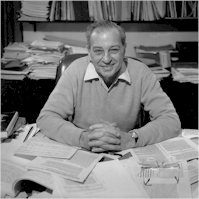
| THE INTEGRITY PAPERS | Genre Group | ceptualinstitute.com/genre.htm |
This page is the Ceptual Institute mirror
of a page from the RAMarcus/CalTech
website. (2000)

(b. 1923) Arthur Amos Noyes Professor of Chemistry.
B.Sc., 1943, Ph.D., 1946, McGill University;
Postdoctoral Fellow, 1946-49, National Research Council, Canada;
Postdoctoral Fellow, 1949-51, University of North Carolina.
| SELECTED PUBLICATIONS "A Sequential Formula for Electronic Coupling in Long Range Bridge-Assisted Electron Transfer. Formulation of Theory and Application to Alkanethiol Monolayers," C.-P. Hsu and R. A. Marcus, J. Chem. Phys. 106, 584 (1997). "Time-Dependent Stokes Shift and its Calculation from Solvent Dielectric Dispersion Data," C.-P. Hsu, X. Song, and R. A. Marcus, J. Phys. Chem. B 101, 2546 (1997). "Electron Transfer Model for the Electric Field Effect on Quantum Yield of Charge Separation in Bacterial Photosynthetic Reaction Centers," S. Tanaka and R. A. Marcus, J. Phys. Chem. B 101, 5031 (1997). "Transition State Theory and Experiments in Chemical Reactions," R. A. Marcus, in Femtochem. & Femtobiol.: Ultrafast Reaction Dynamics at the Atomic-Scale Resolutions. Nobel Symposium 101, V. Sundstrom, ed., (Imp. Coll. Press, London, 1997), p. 54. "Time-Dependent Fluorescence Spectra of Large Molecules in Polar Solvents," C.-P. Hsu, Y. Georgievskii, R. A. Marcus, J. Phys. Chem. A 102, 2658 (1998). "Interaction of Theory and Experiment in Reaction Kinetics," R. A. Marcus, In Comprehensive Chemical Kinetics, G. Hancock and R. Compton, eds. (Elsevier, Amsterdam) vol. 37, 1 (1999). "Linear Response in Theory of Electron Transfer Reactions as an Alternative to the Molecular Harmonic Oscillator Model," Y. Georgievskii, C.-P. Hsu, R. A. Marcus, J. Chem. Phys. 110, 5307 (1999). "An Intramolecular Theory of the Mass-Independent Isotope Effect for Ozone. I," B. C. Hathorn, R. A. Marcus, J. Chem. Phys. 111, 4087 (1999).
|
Professor Marcus' group formulates and investigates theories of chemical reactions, including electron transfer processes in solution, in proteins, and at interfaces, and of unimolecular reactions, and intramolecular dynamics. In the field of electron transfer reactions, recent theoretical studies here include solvent dielectric dispersion effects on electron transfer reaction rates and on the relaxation of polar solvent molecules around photoexcited charge transfer solutes. Another set of studies are of the effect of donor/acceptor electronic coupling on the reaction rates, as in the dependence of the electronic coupling matrix elements for electron transfer in rigid bridged systems. The method was extended to electron transfers in proteins, initially using an artificial intelligence (AI) technique to select the more important amino acids involved in the donor/acceptor electron transfer. The mechanism is principally one of electronic superexchange. Most recently, a fast "sparse matrix" technique was introduced to include all of the amino acids and to test the AI results. Each of these studies and those described below were stimulated by experiments, and one focus in this work, and that described below, is on the comparison of theory and experiment. The electron coupling studies were extended by introducing a recursion method to treat successive bonds or groups between donor and acceptor. Applications include the treatment of electron transfer along long chain alkanethiols attached to metal electrodes. It is planned to adapt it to treat long range electron transfer in proteins. Related topics studied are rates of electron transfer at semiconductor electrode/liquid interfaces and at interfaces between liquids and different metal electrodes. One aspect of the latter is the relative effectiveness of s(Au, Ag) vs d(Pt, Pd) electrons for these electron transfer rates. Further studies were made on electric field effects on electron transfers in photosynthesis. In another area, unimolecular dissociation reactions and bimolecular association reactions, such as ozone formation from O + O2, the dynamics of the processes are being explored, with the goal of explaining some unusual experimental results on the mass-independent isotpic effect in ozone formation. Another problem stimulated by current experimental results concerns intramolecular vibrational energy randomization in unimolecular reactions. When the amount of vibrational energy is low, the density of directly coupled zeroth-order vibrational states in a molecule is relatively low, and we treated the behavior using a superexchange "tier structure" (off-resonant) mechanism, using an AI search. The ideas were tested by comparing with spectral data on overtones. At higher energies, important in unimolecular reactions, a different ("resonant") mechanism is expected, because of the high density of directly coupled states. It is planned to treat recent data on the time scale of randomization using such a description. The research is supported by NSF and ONR. |
Return to chemistry faculty page

Rudolph Marcus - I/CI Homepage
Integrity / Ceptual Institute Links
Genre Writers
Poetics
Math
